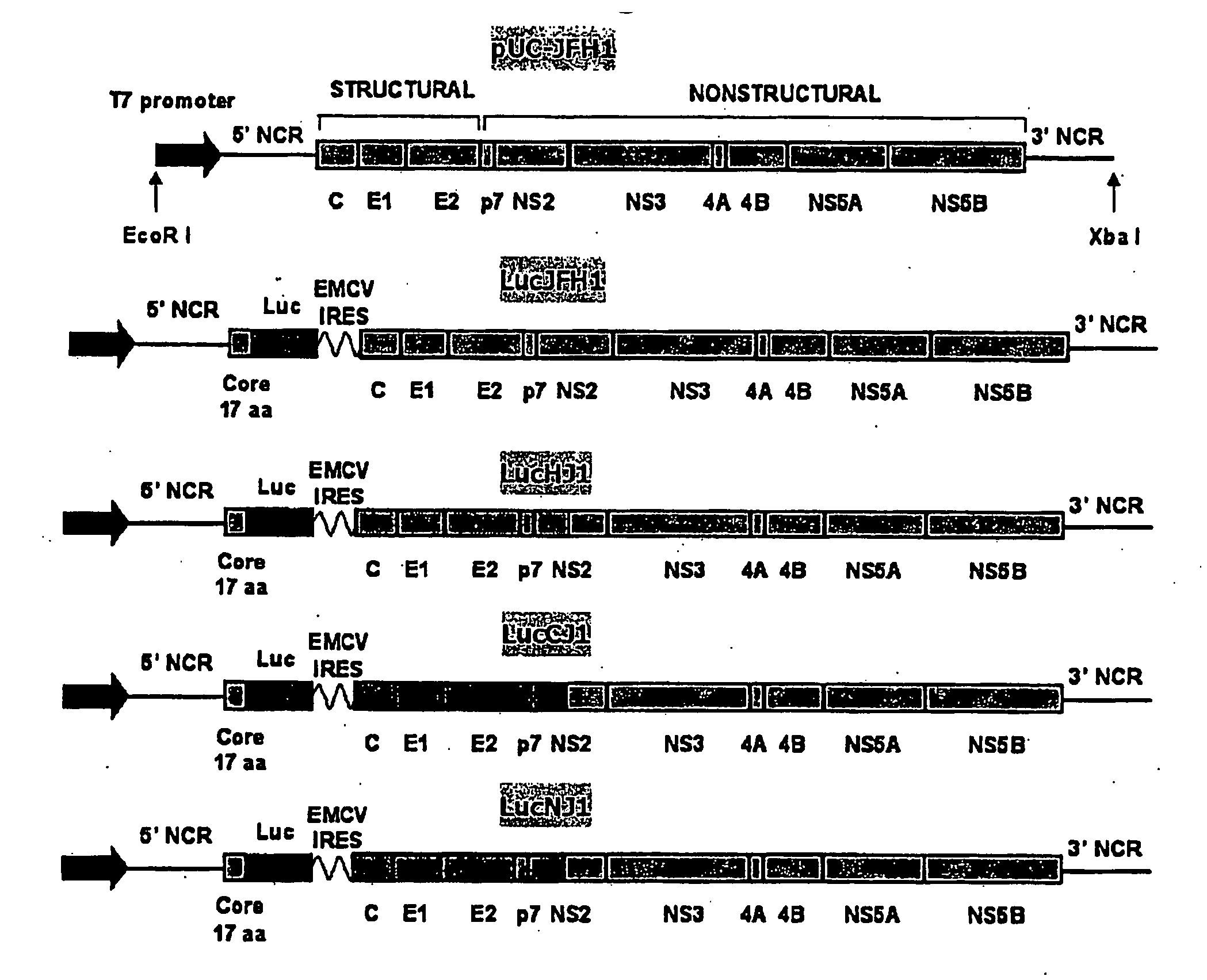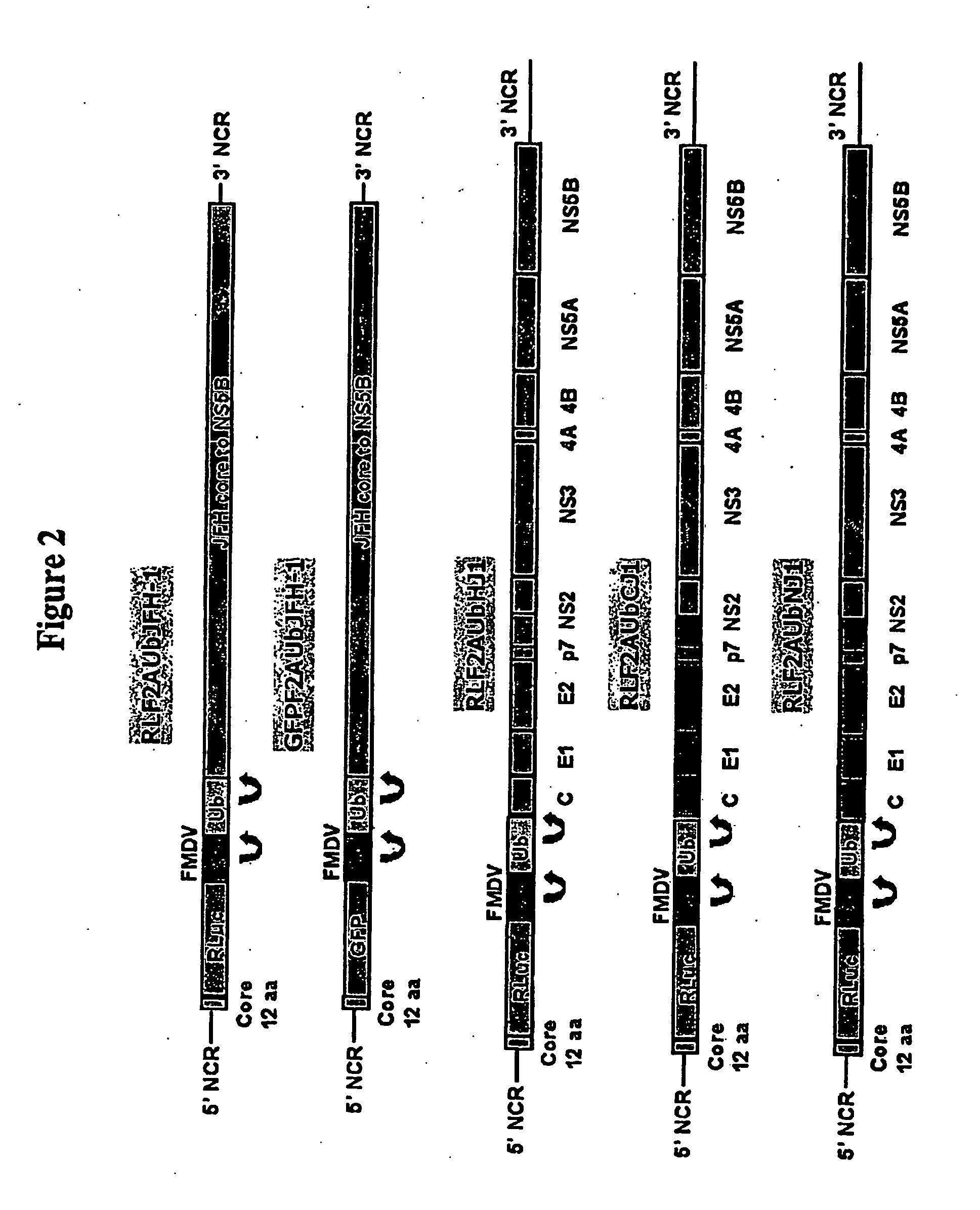Tissue culture system for production of hepatitis c virus
a technology of hepatitis c virus and culture system, which is applied in the field of tissue culture system for production of infectious hepatitis c virus, can solve the problems of large incidence of hcv infection in developing countries, hcv growth has been found to be poor in cell culture, and the development of anti-viral drugs and vaccines against hcv infection has been hindered, so as to achieve the effect of increasing the yield of viral particles
- Summary
- Abstract
- Description
- Claims
- Application Information
AI Technical Summary
Benefits of technology
Problems solved by technology
Method used
Image
Examples
example 1
General Materials and Methods
Cells
[0195]Huh-7
[0196]Human hepatoma cell line Huh-7 (Cancer Res 42:3858-63) was maintained in Dulbecco's modified Eagle medium (DMEM) (Invitrogen, Carlsbad, Calif.) containing high glucose, 10% fetal bovine serum, L-glutamine, and non-essential amino acids, at 37° C. in 5% CO2. Unless otherwise indicated, all cell culture in presence of HCV was performed as described and referenced herein.
[0197]Huh7C
[0198]Interferon-cured Huh7 (Huh7C) cells were prepared by treating Huh7 cells containing a subgenomic replicon with interferon-α at a concentration of 100 U / ml of culture for 14 days, as described previously by Kanazawa et al. (J. Virol. (2004) 78:9713-9720). Briefly, cured Huh7 cells, from which the replicon had been eliminated, were established by treating Huh7 / Rep-Neo cells with 100 U of IFN-α / ml for 14 days. Clearance of replicon RNA was confirmed by reverse transcription-PCR (RT-PCR) and by the loss of resistance to G418.
[0199]T7-11
[0200]Five million H...
example 2
Recombinant JFH1 Genomic Bicistronic Constructs
[0205]Several wild-type and chimeric JFH1 genomic constructs were prepared (see FIG. 1). A recombinant wild-type JFH1 genomic construct contained within a pUC18 plasmid as shown in the sequence of SEQ ID NO:1 was prepared as described previously (Wakita et al. (2005) Nature Medicine 11:791-796; herein incorporated by reference in its entirety). This construct includes open reading frames for HCV proteins core, E1, E2, p7, NS2, NS3, NS4A, NS4b, NS5a, and NS5b, flanked by 5′ and 3′ untranslated regions, and a T7 promoter.
[0206]In addition, a bicistronic wild-type JFH1 genomic construct (LucJFH1) comprising the sequence of SEQ ID NO:2 was generated that included a first cistron encoding the first 17 amino acids of the JFH1 core protein linked to a luciferase reporter gene for monitoring viral infection and RNA replication. This bicistronic construct also included an encephalomyocarditis virus (EMCV) internal ribosomal entry site (IRES) for...
example 3
Recombinant JFH1 Genomic Monocistronic Constructs
[0208]Several monocistronic wild-type and chimeric JFH1 genomic constructs were also prepared (see FIG. 2). Monocistronic constructs included a region encoding the first 12 amino acids of the JFH1 core protein linked to a green fluorescent protein (GFP) or a Renilla luciferase (RLuc) reporter gene, a coding sequence for a foot-and-mouth disease virus (FMDV) 2A protease, a coding sequence for a ubiquitin protease cleavage site, and a wild-type JFH I or chimeric polyprotein coding region. In some of these chimeric constructs, the polyprotein coding region comprised NS3 to NS5b sequences derived from strain JFH1 and core to p7 sequences derived from a second HCV isolate, linked by a chimeric NS2 coding region with an intergenotypic junction at residue 871 (RLF2AUba1 and RLF2AUbHJ1) or 877 (RLF2AUbNJ1) of NS2. Monocistronic constructs included plasmids encoding chimeric DNA constructs of the invention as follows: (a) RLF2AubJFH-1, as in S...
PUM
| Property | Measurement | Unit |
|---|---|---|
| Time | aaaaa | aaaaa |
| Time | aaaaa | aaaaa |
| Time | aaaaa | aaaaa |
Abstract
Description
Claims
Application Information
 Login to View More
Login to View More - R&D
- Intellectual Property
- Life Sciences
- Materials
- Tech Scout
- Unparalleled Data Quality
- Higher Quality Content
- 60% Fewer Hallucinations
Browse by: Latest US Patents, China's latest patents, Technical Efficacy Thesaurus, Application Domain, Technology Topic, Popular Technical Reports.
© 2025 PatSnap. All rights reserved.Legal|Privacy policy|Modern Slavery Act Transparency Statement|Sitemap|About US| Contact US: help@patsnap.com



